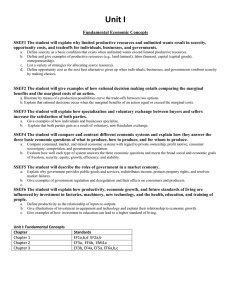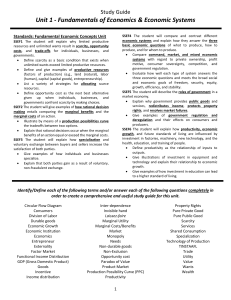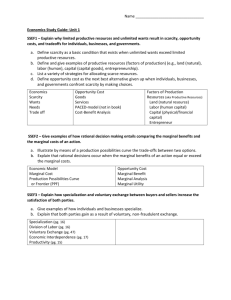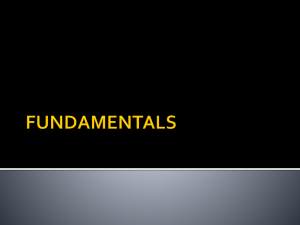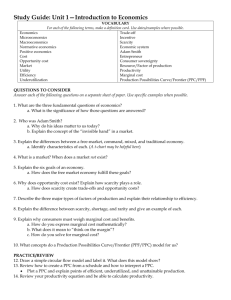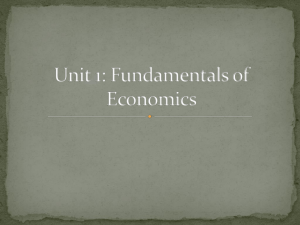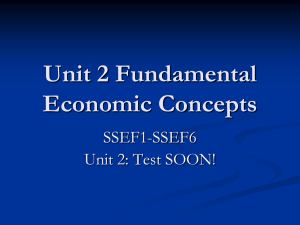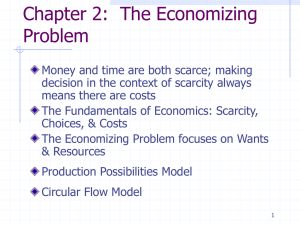File - The Adamson Adventure
advertisement
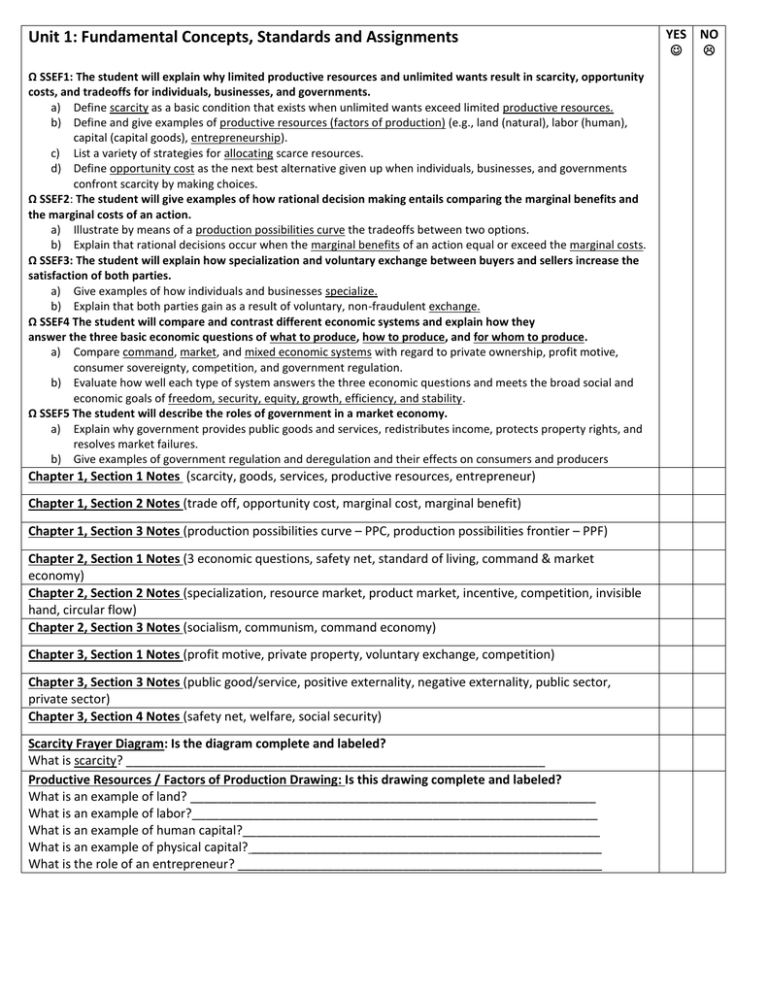
Unit 1: Fundamental Concepts, Standards and Assignments Ω SSEF1: The student will explain why limited productive resources and unlimited wants result in scarcity, opportunity costs, and tradeoffs for individuals, businesses, and governments. a) Define scarcity as a basic condition that exists when unlimited wants exceed limited productive resources. b) Define and give examples of productive resources (factors of production) (e.g., land (natural), labor (human), capital (capital goods), entrepreneurship). c) List a variety of strategies for allocating scarce resources. d) Define opportunity cost as the next best alternative given up when individuals, businesses, and governments confront scarcity by making choices. Ω SSEF2: The student will give examples of how rational decision making entails comparing the marginal benefits and the marginal costs of an action. a) Illustrate by means of a production possibilities curve the tradeoffs between two options. b) Explain that rational decisions occur when the marginal benefits of an action equal or exceed the marginal costs. Ω SSEF3: The student will explain how specialization and voluntary exchange between buyers and sellers increase the satisfaction of both parties. a) Give examples of how individuals and businesses specialize. b) Explain that both parties gain as a result of voluntary, non-fraudulent exchange. Ω SSEF4 The student will compare and contrast different economic systems and explain how they answer the three basic economic questions of what to produce, how to produce, and for whom to produce. a) Compare command, market, and mixed economic systems with regard to private ownership, profit motive, consumer sovereignty, competition, and government regulation. b) Evaluate how well each type of system answers the three economic questions and meets the broad social and economic goals of freedom, security, equity, growth, efficiency, and stability. Ω SSEF5 The student will describe the roles of government in a market economy. a) Explain why government provides public goods and services, redistributes income, protects property rights, and resolves market failures. b) Give examples of government regulation and deregulation and their effects on consumers and producers Chapter 1, Section 1 Notes (scarcity, goods, services, productive resources, entrepreneur) Chapter 1, Section 2 Notes (trade off, opportunity cost, marginal cost, marginal benefit) Chapter 1, Section 3 Notes (production possibilities curve – PPC, production possibilities frontier – PPF) Chapter 2, Section 1 Notes (3 economic questions, safety net, standard of living, command & market economy) Chapter 2, Section 2 Notes (specialization, resource market, product market, incentive, competition, invisible hand, circular flow) Chapter 2, Section 3 Notes (socialism, communism, command economy) Chapter 3, Section 1 Notes (profit motive, private property, voluntary exchange, competition) Chapter 3, Section 3 Notes (public good/service, positive externality, negative externality, public sector, private sector) Chapter 3, Section 4 Notes (safety net, welfare, social security) Scarcity Frayer Diagram: Is the diagram complete and labeled? What is scarcity? _____________________________________________________________ Productive Resources / Factors of Production Drawing: Is this drawing complete and labeled? What is an example of land? ___________________________________________________________ What is an example of labor?___________________________________________________________ What is an example of human capital?____________________________________________________ What is an example of physical capital? ___________________________________________________ What is the role of an entrepreneur? _____________________________________________________ YES NO Decision Making Activity “Four Corners” What would be a cost (negative) of owning an SUV? What would be a benefit (positive)? What is a trade off? What was your opportunity cost for coming to school today? Production Possibilities Handout: What can a PPC show us? What can shift the PPC inwards? What can shift it outwards? Economic Systems Graphic Organizer What are the three economic questions? How does a command/centrally planned economy answer these questions? How does a market economy answer these questions? Economic Goals Activity & Notes What are the six economic goals that each economic system must address? Which are most important to command economies? Which are most important to market economies? Circular Flow Drawing: Is it correctly labeled? What do households supply the resource/factor market?________________________________ What does the resource market supply households? ______________________________ Circular Flow Handout: How do households depend on business firms in the product market?____________________________________________________________________________________ How do businesses depend on households in the resource/factor market? Unit 1 Test over SSEF1, SSEF2, SSEF3, SSEF4, SSEF5 – What grade did I earn on my test? _________________ Which area gave you the most trouble? ______________________________________
